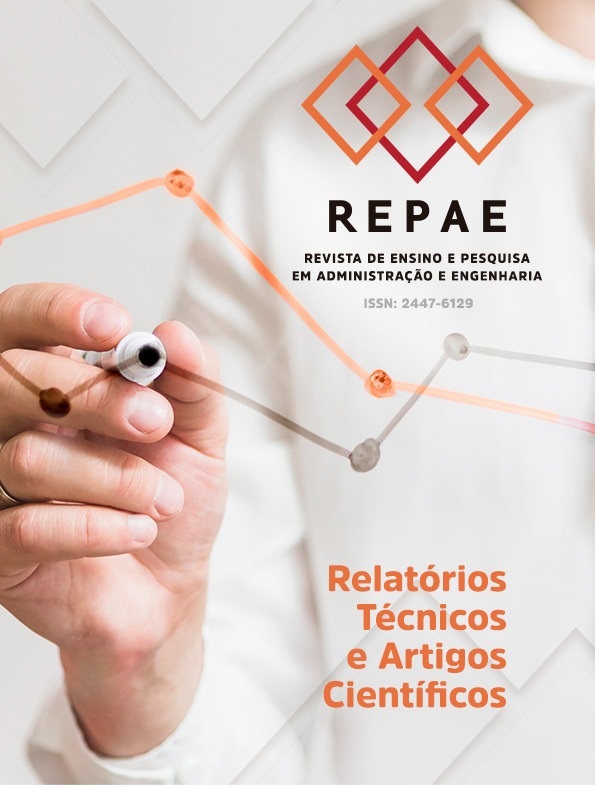Mapping a Pricing Process through a Fuzzy Inference System
decision-support for a small business entrepreneur
DOI:
https://doi.org/10.51923/repae.v8i2.305Keywords:
Fuzzy Logic, Pricing, Fuzzy Inference System, Small BusinessAbstract
Many business owners face struggles in determining their prices even with great experience and knowledge in their fields. The present paper addresses one case of this issue: a professional and entrepreneur that offers mechanical and lathe services in his own workshop. The goal of this work was to map the intuitive pricing process of the entrepreneur through a Fuzzy Inference System (FIS). Many fuzzy aspects such as the imprecision, uncertainty, and ambiguity of these lathe and maintenance services were related to the potential benefits of FIS, clarifying which methods were used and why. This FIS was constructed to mimic the empirical pricing process of the referred professional and, in this task, this project was successful. Output surfaces showed that complexity and goods value have significant effects just above medium levels and that their impact has a smaller weight than the estimated time. Furthermore, some unexpected outcomes were reached in the system development. Not only was the entrepreneur's reasoning mapped but it also provided more understanding of his own market.
Downloads
References
Alfaro V. G., Gil-Lafuente, A. M., & Alfaro C.G. 2015.A Fuzzy Logic Approach Towards Innovation Measurement. Global Journal of Business Research, 9(3): 53-71. https://ssrn.com/abstract=2664305
Andrade, M., & Jaques, M. A. P. 2008. Estudo comparativo de controladores de Mamdani e Sugeno para controle de tráfego em interseções isoladas. Associação Nacional de Pesquisa e Ensino em Transportes. 16(2): 24-31. https://doi.org/10.14295/transportes.v16i2.24
Bodjanova, S.2000. Fuzzy Partitions. A. Ferligoj and A. Mrvar (Eds), In: New Approaches in Applied Statistics: 39-62. University of Ljubljana, Ljubljana,
Cherri, A. C., Junior, D. J. A., & da Silva, I. N. 2011. Inferência fuzzy para o problema de corte de estoque com sobras aproveitáveis de material. Pesquisa Operacional, 31(1): 173-195. http://dx.doi.org/10.1590/S0101-74382011000100011
García, J. S., & Velásquez, J. R. 2013. Methodology for Evaluating Innovation Capabilities at University Institutions Using a Fuzzy System. Journal of technology management & innovation. 8(1): 51-51. http://dx.doi.org/10.4067/S071827242013000300051.
Gonzalez, A., & Perez, R. 1998. Completeness and consistency conditions for learning fuzzy rules. Fuzzy Sets and Systems, 96(1): 37-51. https://doi.org/10.1016/S01650114(96)002801
Herrera, F., Herrera-Viedma, E., & Martinez, L. 2002. Representation Models for Aggregating Linguistic Information: Issues and Analysis. Aggregation operators: New trends and applications. Heidelberg, Physica-Verlag, .245-259. https://doi.org/10.1007/9783790817874_8
Hurtado, M.S. 2006. Estado de la cuestión acerca del uso de la lógica difusa en problemas financieros. Cuadernos de Administración, 19(32): 195-223.
Kaur, A. & Kaur, A. 2012. Comparison of Mamdani-Type and Sugeno-Type Fuzzy Inference Systems for Air Conditioning System. System.International Journal of Soft Computing and Engineering, 2(2): 323-325. DOI: 10.1109/ICACEA.2015.7164799
Legewie, N.2017.Anchored Calibration: From Qualitative Data to Fuzzy Sets. Forum Qualitative Sozialforschung / Forum: Qualitative Social Research. 18(3). http://dx.doi.org/10.17169/fqs-18.3.2790
Mamdani, E. H. 1974. Application of fuzzy algorithms for control of simple dynamic plant. Proceedings of the Institution of Electrical Engineers, 121(12): 1585-1588. DOI: 10.1049/piee.1974.0328
Meyer, A., & Zimmermann, H.-J. 2011. Applications of Fuzzy Technology in Business Intelligence. International Journal of Computers Communications & Control, 6(3): 428-441 DOI:10.15837/IJCCC.2011.3.2128
Pedrycz, W., Gomide, F., 2007.Fuzzy systems engineering: toward human-centric computing, John Wiley: Hoboken, NJ, USA
Ramirez, J. 2010. Metodología para Medir y Evaluar las Capacidades Tecnológicas de Innovación Aplicando Sistemas de Lógica Difusa: Caso Fábricas de Software Masters Thesis Universidad Nacional de Colombia: Escuela de la Organización, Medellín.
Roger Jang, J. S., Gully, N., & MathWorks, Inc. 2016. MATLAB Fuzzy Logic Toolbox: User’s Guide.
Takagi, T., & Sugeno, M. 1993. Fuzzy Identification of Systems and Its Applications to Modeling and Control. IEEE Transactions on Systems, Man, and Cybernetics, 15(1):116–132. DOI: 10.1109/TSMC.1985.6313399
Zadeh, L. A. 1965. Fuzzy sets. Information and Control. Academic Press. 8(3): 338-353. https://doi.org/10.1016/S0019-9958(65)90241-X
Zadeh, L. A. 1973. Outline of a New Approach to the Analysis of Complex Systems and Decision Processes. IEEE Transactions on Systems, Man, and Cybernetics.SMC-3(1): 28-44. DOI: 10.1109/TSMC.1973.5408575
Zhang, Y., Chen, H., Lu, J., & Zhang, G. 2017. Detecting and predicting the topic change of Knowledge-based Systems: A topic-based bibliometric analysis from 1991 to 2016. Knowledge-Based Systems. 133: 255-268 https://doi.org/10.1016/j.knosys.2017.07.011
Downloads
Published
How to Cite
Issue
Section
License
Copyright (c) 2022 vitor miano, Arthur Azevedo Battisaco, Arthur Gebhard Martin dos Santos

This work is licensed under a Creative Commons Attribution 4.0 International License.
Esta obra está licenciada sob uma licença Creative Commons Atribuição - No comercial - Sin derivaciones 4.0 Internacional
1.O(s) autor(es) autoriza(m) a publicação do artigo na revista;
2.O(s) autor(es) garante(m) que a contribuição é original e inédita e que não está em processo de avaliação em outra(s) revista(s);
3.A revista não se responsabiliza pelas opiniões, ideias e conceitos emitidos nos textos, por serem de inteira responsabilidade de seu(s) autor(es);
4.É reservado aos editores o direito de proceder ajustes textuais e de adequação do artigos às normas da publicação.
1.1 Copyright Statement
This journal is licensed under a Creative Commons Attribution-Non Commercial-No Derivers 4.0 International license.
1. The author (s) authorize the publication of the article in the journal;
2. The author (s) warrant that the contribution is original and unpublished and is not in the process of being evaluated in other journal (s);
3. The journal is not responsible for the opinions, ideas and concepts emitted in the texts, as they are the sole responsibility of its author (s);
4. The editors are entitled to make textual adjustments and to adapt the articles to the standards of publication.






